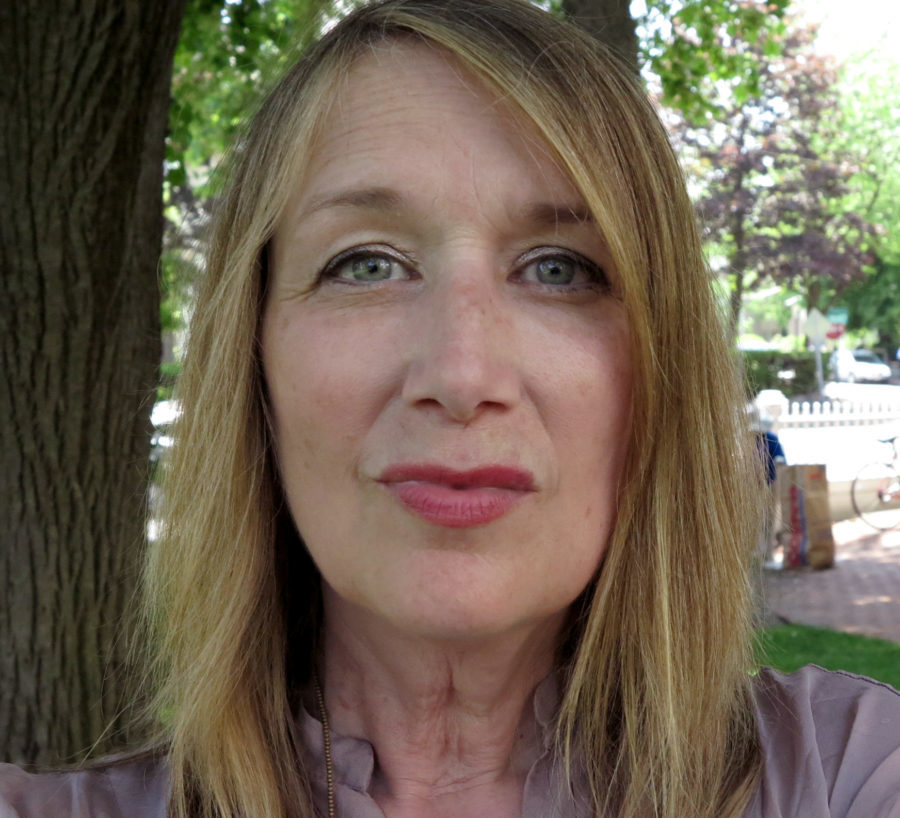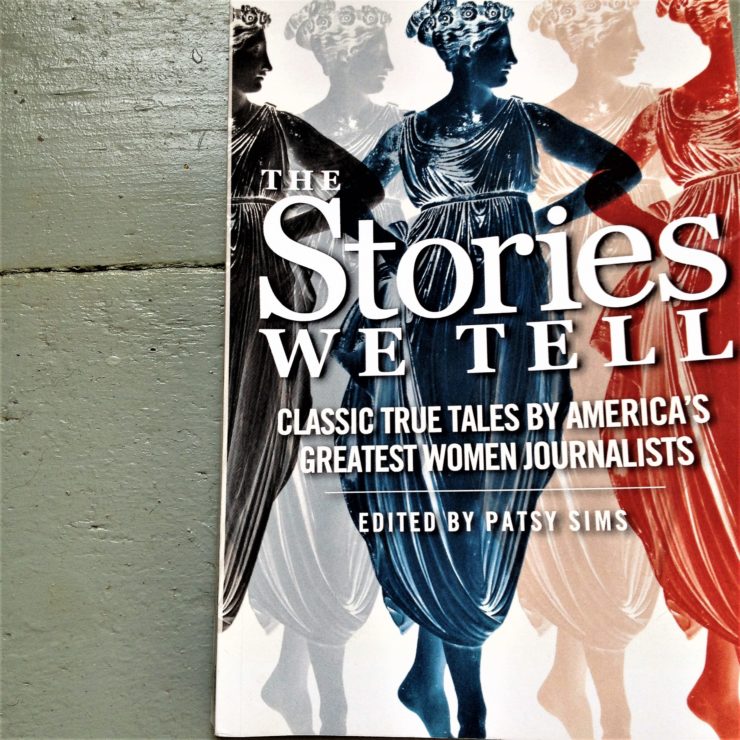
The 1967 edition of the annual “Best Magazine Articles” anthology has six names on the cover: Gay Talese, Gore Vidal, Stephen Becker, Conrad Aiken, Conrad Knickerbocker and Tom Wolfe. Underneath those names it says, “and others.”
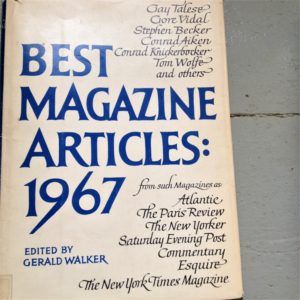 You open the book, and see that one of the “others” is … Joan Didion. And the article is the wonderful “How Can I Tell Them There’s Nothing Left?” (which is more well known as “Some Dreamers of the Golden Dream”).
You open the book, and see that one of the “others” is … Joan Didion. And the article is the wonderful “How Can I Tell Them There’s Nothing Left?” (which is more well known as “Some Dreamers of the Golden Dream”).
Really? You couldn’t have replaced one of the six guys – one of the Conrads, say – with not only a woman, but one of the greatest longform writers in the country?
It only took 50 years for the women of longform journalism to really get their due in an anthology, the newly published “The Stories We Tell: Classic Tales by America’s Greatest Women Journalists.” Among the writers included? Joan Didion. And her now-classic “Some Dreamers of the Golden Dream,” which includes a line I’ve always loved: “The future looks good in the golden land, because no one remembers the past.”
The anthology is a feast of great writing by 20 journalists at the top of their game, including the late Lillian Ross, Madeleine Blais, Gerri Hirshey, Susan Orlean and Jill Lepore.
And now the biggest question is, why did it take so long?
“It is both incredible and a shame that it has taken so long for the literary journalism by American women to be showcased in an anthology,” says the anthology’s editor, Patsy Sims. “The fact is, women have long played a key role in shaping the genre.”
I talked to Sims about the genesis of the book, how the stories were chosen and Gay Talese’s inability a few years ago to name a woman writer who inspired him. The interview, conducted via email, has been slightly edited and condensed.
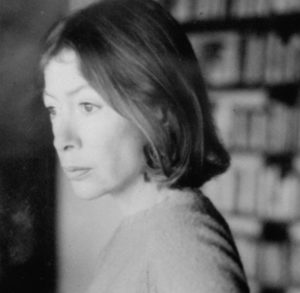
Joan Didion in June 1979.
Let’s start at the beginning. Who had the idea for the book? As far as you know, is it the first of its kind, focusing on women literary journalists?
I dearly wish I could take credit, but the idea was Mike Sager’s. I’m just lucky he thought to invite me to edit the anthology. It is the second in a series of texts/anthologies devoted to female journalists undertaken by Mike and The Sager Group. The series grew out of a promise he made at a 2013 University of Missouri conference to do his part to foster women in journalism. Kaylen Ralph and Joanna Demkiewicz, the two young women who prompted that promise, are editing the third anthology, “More Stories We Tell: True Tales by America’s New Generation of Great Women Journalists,” due out next fall. “Newswomen: Twenty-five Years of Front-Page Journalism,” edited by Joyce Hoffmann, came out two years ago. To the best of my knowledge, it is the first series of anthologies to focus solely on the literary journalism of American women.
I’m curious about the title. How did you come up with it? It’s not overtly feminine – was that deliberate? (But it does include the word “we,” which has an inclusive, chat-around-the-table feel).
The title actually comes from the opening line of Joan Didion’s essay “The White Album”: “We tell ourselves stories in order to live.” Mike and I thought it was the perfect title for our collection. I don’t think either of us thought about whether it was feminine or not—it just seemed to fit what the book was about. The “we” seemed to embody the spirit and enthusiasm that developed among the contributors and Mike and me as the book came together. I think we all sensed the collection was an important moment for women writers, and we were all excited to be a part of it.
“I can name any number of women who have never shied away from uncomfortable encounters. In my own career, I have written books about the Ku Klux Klan and religious snake-handlers. I spent a year inside a Texas men’s prison for the book I am currently working on.”
How did you pick the writers?
I started with a wish list of the women I hoped to see in such an anthology. I also reached out to editors, writers, and educators for their suggestions, and then, of course, Mike had a wish list, too. We ended up with a list that could have filled an encyclopedia, which led to the decision to do a second volume–and even then many women we would have liked to include had to be omitted. It was difficult having to cut writers we admired, and yet it was gratifying to see just how many incredible women are writing and publishing literary journalism.
From your introduction, it seems like the writers chose which stories they wanted to include. Is that right? And do you have any insight on how they made their choices? Many of the stories are about women, but not all of them are.
I embarked on the project knowing there were some stories I very much wanted to use—Didion’s “The Dreamers of the Golden Dream,” for example, but Mike and I also felt it was important for the women to have a say in what we included. For the most part, I asked the women to suggest three stories, and Mike and I chose the one we thought best for the mix we hoped to end up with. I’m sure the women had any number of reasons for suggesting the stories they did, but my guess would be that they wanted most of all to put forth their best work.
While many of the stories are about women, they are not what used to be thought of as “typical” women’s stories—fashion, food, parenting. Except for Joyce Wadler’s piece on her mastectomy, I’d say most could have been written by men, albeit from a different stance. I have long believed that a woman could write—and write well—about any subject that a man does. One of my fondest memories is winning Best Sports Story of the Year in the 1968 New Orleans Press Club Awards, beating out three male finalists.
I want to cite a couple of the quotes from the writers you have on the first page of the book, and ask you to riff on them. First off, the one from Madeleine Blais (who won the second features Pulitzer ever handed out): “One of the many beauties of nonfiction as a genre is that it invites diversity in the stories it seeks to tell and, by extension, in the practitioners who tell those stories. At long last, the contributions of women as leaders in this field are being fully acknowledged.”
I love this quote. We could talk a long, long time just about the diversity nonfiction fosters. Actually, I would insert the adjectives “literary” or “narrative” because to me the strength of the genre is its potential to draw readers into subjects they never felt they were interested in because of the artistry and power of the writing itself. Take Mimi Swartz’s “Mothers, Sisters, Daughters, Wives.” The Texas Legislature’s war on women’s reproductive rights is not a subject many of us would choose to read about, and yet in Swartz’s hands you simply can’t stop reading. It is an incredible piece of writing.
The diversity of the stories in the collection, I think, speaks to the diversity of stories that become possible in the hands of capable narrative or literary nonfiction writers. The genre offers writers such great possibilities.
It is both incredible and a shame that it has taken so long for the literary journalism by American women to be showcased in an anthology. The fact is, women have long played a key role in shaping the genre. We have only to look at the women included here to see just how long. The late Lillian Ross was at work at The New Yorker in 1945. Joan Didion was publishing in Saturday Evening Post in the 1960s. Gloria Steinem’s piece on Jacqueline Kennedy appeared in Esquire in 1964. And if you want to go back even farther, there was Martha Gellhorn sending dispatches from World War II and Mary McCarthy from Vietnam.
From Adrian LaBlanc: “I won’t be here to witness it, but won’t it be a fine day when anthology specifically focused on women journalists won’t make any sense?” (It’s her certainty that she won’t be here to witness it that stays with me.)
I take her quote to mean she hopes the anthology is the beginning of female journalists receiving their due, and that henceforth they will receive the same assignments and the same recognition as men, long after we are all gone.
“It is both incredible and a shame that it has taken so long for the literary journalism by American women to be showcased in an anthology. The fact is, women have long played a key role in shaping the genre. We have only to look at the women included here to see just how long.”
On a related note, do you remember the controversy a few years ago at a literary journalism conference when Gay Talese was asked which women writers he admired, and he couldn’t come up with even one? He proceeded to make it worse by mansplaining about how women just “do not feel comfortable dealing with strangers.” Can you talk about that a little?
I take great exception with Talese on that. What about Didion and her encounters in Haight-Asbury and El Salvador, for example? What about Gerri Hirshey on the bus with B.B. King? And Jeanne Marie Laskas and the man with the transplanted face? And Adrian Nicole LeBlanc and her powerful book “Random Family”? I can name any number of women who have never shied away from uncomfortable encounters. In my own career, I have written books about the Ku Klux Klan and religious snake-handlers. I spent a year inside a Texas men’s prison for the book I am currently working on.
Interestingly, Mike and I embarked on this anthology in 2013, three years before the Talese brouhaha.
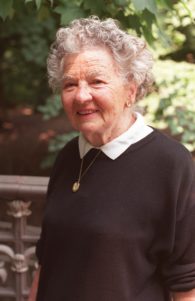
Author Lillian Ross in 1997.
One of your writers, the legendary Lillian Ross, just died. Her career was almost beyond belief: more than 60 years at The New Yorker, and she was still filing stories until not that long ago. Are you a fangirl? I think they should do a movie about her!
Hmmm, I never heard the phrase “fangirl,” but, yes, I’m very much an admirer. I was delighted when we were able to include her in the anthology. She has published several collections of her own work, but I think we may be the first anthology to include her. To me, our goal of paying tribute to the women who have played a role in shaping the genre would have been incomplete without her. As a writer, I’ve learned a lot from her about bringing people to life on paper, and her longevity encourages me to keep going! In the months before her death, Ms. Ross worked closely with us through her wonderful agent Jane Gelfman, who reports that she was able to see the galleys and was pleased that such a book was being published.
A few more questions sparked by Lillian Ross. The New York Times obit cites her credo in her book “Reporting.” “Your attention at all times should be on your subject, not on you. Do not call attention to yourself.” Do you think that’s easier for women writers, to focus on someone else and disappear?
It’s a good credo, and one I’ve encouraged my students to work at over the years. I’ve never really thought about whether it was easier for women to stay in the background than it is for men. That may well be true, but then I think of some of the wonderful stories by Walt Harrington and Mike Sager that would totally contradict that. Mike wrote a wonderful piece for Esquire about a 92-year-old man that is a model for the writer fading into the background. I think, too, of Walt’s piece about a Washington, DC, homicide detective that absolutely calls no attention to the writer. I guess I have never felt that men and woman necessarily report and write differently because of their sex. To me, there are good writers and there are bad writers of both sexes.
And I love that either she or you chose not one of her epic pieces, but a selection of her Talk of the Towns, the short, “light” pieces in The New Yorker. I underlined so many things in her introduction, but I’ll ask you about this one: “Good reporting can be long or short, and I love it whatever its length.” I’ve always rebelled at the idea that great writing must be epic in length. I’m so thrilled you included these jewels. Did it mean a lot for you to have this in the mix?
Actually, the use of the Talk pieces was originally somewhat an accident. We first set out to run a long piece, like the others in the book, but I ran into difficulty because of an agreement that I couldn’t use a story that was included in her own collections. As it turns out, using the Talk pieces was absolutely right-on given Ms. Ross’s love of Talk of the Town. The tone and the humor of the pieces I selected are also so Lillian Ross. I love the excerpt we were able to include from the introduction to her own collection of Talk pieces. There’s a lot of writing wisdom there.
Do you have a favorite piece of the collection? And if that’s too Sophie’s Choice, does one particularly resonate with you?
Please don’t make me answer this! I simply can’t pick a favorite. It goes along with my feeling that the stories in anthologies should be published in alphabetical order to avoid favoring one writer over another. I hate books and conferences that advertise “So-and-so, among others.” I would have hated to go to press without a single one of these stories.


